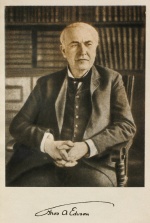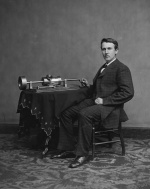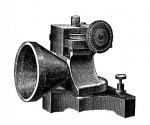Thomas Alva Edison: Difference between revisions
| Line 20: | Line 20: | ||
In the quote above she was referring to Edison's view of [[matter]], which was against the current scientific ideas but in accord with the Theosophical view. Mme. Blavatsky quoted him as follows: | In the quote above she was referring to Edison's view of [[matter]], which was against the current scientific ideas but in accord with the Theosophical view. Mme. Blavatsky quoted him as follows: | ||
<blockquote>I do not believe that matter is inert, acted upon by an outside force. To me it seems that every atom is possessed by a certain amount of primitive intelligence: look at the thousand ways in which atoms of hydrogen combine with those of other elements. . . Do you mean to say they do this without intelligence?<ref>Helena Petrovna Blavatsky, ''Collected Writings'' vol. XII (Wheaton, IL: Theosophical Publishing House, 1980), 130. Attributed by Blavatsky as "quoted in the London magazines from ''Harper's''."</ref></blockquote> | <blockquote>I do not believe that matter is inert, acted upon by an outside force. To me it seems that every atom is possessed by a certain amount of primitive intelligence: look at the thousand ways in which atoms of hydrogen combine with those of other elements. . . Do you mean to say they do this without intelligence?<ref>Helena Petrovna Blavatsky, ''Collected Writings'' vol. XII (Wheaton, IL: Theosophical Publishing House, 1980), 130. Originally printed in ''Lucifer'' 6.31 (March, 1890), 8. Attributed by Blavatsky as "quoted in the London magazines from ''Harper's''."</ref></blockquote> | ||
== Tasimeter == | == Tasimeter == | ||
Revision as of 14:39, 26 September 2018
Thomas Alva Edison (February 11, 1847 – October 18, 1931) was an American inventor and businessman. He was the fourth most prolific inventor in history, holding 1,093 US patents in his name, as well as many patents in the United Kingdom, France, and Germany. He developed many devices that greatly influenced life around the world, including the phonograph, the motion picture camera, and a long-lasting, practical electric light bulb. Thomas Edison died of complications of diabetes on October 18, 1931, in his home, "Glenmont" in Llewellyn Park in West Orange, New Jersey.
Philosophical views
Edison stated, "I do not believe in the God of the theologians; but that there is a Supreme Intelligence I do not doubt."[1]
Nonviolence was key to Edison's moral views, and when asked to serve as a naval consultant for World War I, he specified he would work only on defensive weapons and later noted, "I am proud of the fact that I never invented weapons to kill." Edison's philosophy of nonviolence extended to animals as well, about which he stated: "Nonviolence leads to the highest ethics, which is the goal of all evolution. Until we stop harming all other living beings, we are still savages".[2] However, he is also notorious for having electrocuted a number of dogs in 1888, both by direct and alternating current, in an attempt to argue that the former (which he had a vested business interest in promoting) was safer than the latter (favored by his rival George Westinghouse).[3]
Theosophical involvement
On April 5, 1878, Edison sent in his signed application for Fellowship in the Theosophical Society, becoming a member in New Jersey.[4] The application was approved on August 27, 1878, placing him as the 162nd person to be admitted to the Society.[5] On December 13 of that year, Col. Olcott went to Menlo Park, to see Edison about the phonograph.
In October 1882, Master K.H. wrote to A. P. Sinnett that Edison was "a good deal protected by M."[6]
Although a number of his views agreed with the Theosophical teachings, he was never very active in Society. As H. P. Blavatsky wrote in 1890:
Mr. Edison is a Theosophist, though not a very active one. Still, the very fact of his holding a diploma seems to inspire him with Theosophical truths.[7]
In the quote above she was referring to Edison's view of matter, which was against the current scientific ideas but in accord with the Theosophical view. Mme. Blavatsky quoted him as follows:
I do not believe that matter is inert, acted upon by an outside force. To me it seems that every atom is possessed by a certain amount of primitive intelligence: look at the thousand ways in which atoms of hydrogen combine with those of other elements. . . Do you mean to say they do this without intelligence?[8]
Tasimeter
When discussing with A. P. Sinnett about undiscovered planets in the Solar System, Master K.H. mentioned one of Edison's invention, the tasimeter, which was designed to measure infrared radiation:
Edison's tasimeter adjusted to its utmost degree of sensitiveness and attached to a large telescope may be of great use when perfected. When so attached the "tasimeter" will afford the possibility not only to measure the heat of the remotest of visible stars, but to detect by their invisible radiations stars that are unseen and otherwise undetectable, hence planets also. . . . His tasimeter, he says, "is affected by a wider range of etheric undulations than the eye can take cognizance of." Science will hear sounds from certain planets before she sees them. This is a prophecy. Unfortunately I am not a Planet, — not even a "planetary." Otherwise I would advise you to get a tasimeter from him and thus avoid me the trouble of writing to you.[9]
In 1931 Karl Jansky built the first radio telescope, and five years later, amateur astronomer Grote Reber applied this technique in the first application of a new branch of astronomy that became known as radio astronomy.[10] Thus, the Master's prophecy was fulfilled about 50 years later. However, Edison was the first scientist on record to have proposed an experiment to detect radio waves from the Sun, in 1890.[11]
Notes
- ↑ The Freethinker (1970), G.W. Foote & Company, Volume 90, p. 147
- ↑ Cited in Innovate Like Edison: The Success System of America's Greatest Inventor by Sarah Miller Caldicott, Michael J. Gelb, page 37.
- ↑ Thomas Edison] at Wikipedia
- ↑ Henry Steel Olcott, Old Diary Leaves First Series (Adyar, Madras: The Theosophical Publishing House, 1974), 466.
- ↑ Theosophical Society General Membership Register, 1875-1942 at http://tsmembers.org/. See book 1, entry 162 (website file: 1A/14).
- ↑ Vicente Hao Chin, Jr., The Mahatma Letters to A.P. Sinnett in chronological sequence No. 93b (Quezon City: Theosophical Publishing House, 1993), 325.
- ↑ Helena Petrovna Blavatsky, Collected Writings vol. XII (Wheaton, IL: Theosophical Publishing House, 1980), 130.
- ↑ Helena Petrovna Blavatsky, Collected Writings vol. XII (Wheaton, IL: Theosophical Publishing House, 1980), 130. Originally printed in Lucifer 6.31 (March, 1890), 8. Attributed by Blavatsky as "quoted in the London magazines from Harper's."
- ↑ Vicente Hao Chin, Jr., The Mahatma Letters to A.P. Sinnett in chronological sequence No. 93b (Quezon City: Theosophical Publishing House, 1993), 325.
- ↑ That Time Thomas Edison Almost Invented the Radio Telescope at io9.com
- ↑ Pre-History of Radio Astronomy at National Radio Astronomy Observatory


